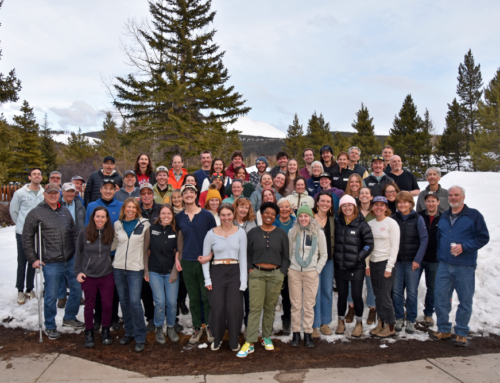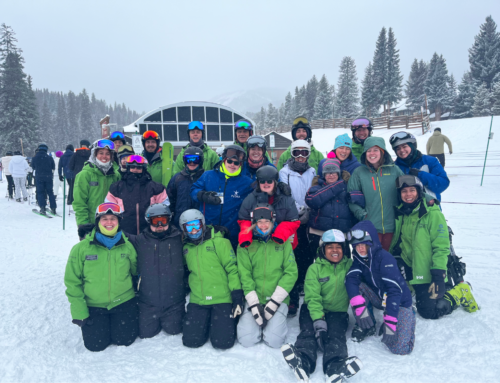Summit Daily News – Antonio Olivero (January 16, 2020)
KEYSTONE — Margie Sinton has a problem with the word “retire.”
To the Silverthorne resident, a Summit local since she and a friend decided to spend the winters as Rocky Mountain ski bums in 1974, the word equates to sitting down, watching TV and “just doing nothing.”
“Uh-uh,” Sinton said, shaking her head at the Keystone Adaptive Center over lunch Wednesday. “I can’t retire.”
How long will she keep that ski-bum spirit alive?
“As long as my legs hold on,” she said.
Nearly a half-century after Sinton found her first job out of college at the then-infant Keystone Mountain ski area, Keystone is still her ski stomping grounds. And for the past dozen years, Sinton has devoted the majority of her ski-instructing time to Keystone Adaptive Center programs.
If you ask Keystone Adaptive Center Ski Program Coordinator Katie Brew, Sinton is the kind of do-everything, know-everything savvy veteran who almost always has prudent advice when it comes to working with the various special-needs clients the adaptive center serves. And she’s the person for which many skiers — former participants with fond memories of working with Sinton — will drop in to say hello.
“In a job like this, in life in general, we’re always learning,” Brew said. “And if you have someone like that to learn from, it’s always valuable. She brings a wealth of knowledge. I have learned within the adaptive realm, you have a collection of tricks that you like to use on lessons and whatnot. And with the amount of experience she has, I feel like she comes in every day with, ‘Hey, have you tried this? Years ago I saw this. Did you try this?’”
This week at the Military Ski & Snowboard Camp for Injured Veterans, a joint program run by the adaptive center and Denver-based Adaptive Adventures, Sinton is employing her best tips and tricks with U.S. military veteran Christopher McAllister.
McAllister, a 33-year-old resident of Colorado Springs, is one of the 15 wounded veterans taking part in this year’s event. It’s McAllister’s third time up at Keystone after the former nuclear reactor operator in the U.S. Navy suffered a traumatic brain injury in the line of duty while on the U.S.S. Dwight D. Eisenhower. After his service ended March 29, 2011, McAllister has tried several sports through Adaptive Adventures.
Working with Sinton this week, McAllister said he was struggling out on the hill Tuesday before Sinton shared one of her tried and true tricks. As McAllister was working to master his balance while parallel skiing, Sinton recommended he shift his focus from his big toe to his little toe. The “big toe, little toe” tip, as McAllister put it, was a breakthrough for him, and it turned a tough Tuesday into a Wednesday with wide smiles.
“The most important part of it is the fundamentals are there,” Sinton said about adaptive instructing. “A ski turns this way, a snowboard turns this way. So you need to break it down to them on how it can turn. …
“Use some flexibility; change what you’d usually do with someone who might not have the full strength, say, in their left side. So we are going to have to work more to make the same things happen. It’s opening up what I like to do to other people. Just because you have a disability doesn’t mean you can’t do it.”
Though McAllister is on normal two-track skis, Sinton has to take into account the special needs surrounding his brain injury, namely double vision and other visual impairments. With that, Sinton said another crucial element of working with students like McAllister is tailoring communication to what works best for them. For McAllister, that meant teaching him to throw up an “X” with his arms when he was in a situation where he wasn’t comfortable skiing. After the duo had a less-than-ideal experience Tuesday on the Gassy Thompson run at Keystone, McAllister threw up that “X” with his hands Wednesday when they passed the top of the same run to let Sinton know he’d rather not ski it again.
Instead, they opted to continue to work on the “big toe, little toe” balance elements to improve his parallel skiing on Keystone’s two most popular beginner runs on Dercum Mountain: Schoolmarm and Silver Spoon.
“I want him to be able to participate and have that big smile,” Sinton said. “That’s the whole goal, that at the end of the day, there’s a big smile on your face.”
“When the skis do line up perfectly with each other,” McAllister added, “it does bring a smile to my face and, ‘Yeah, I just felt that happen!’”





